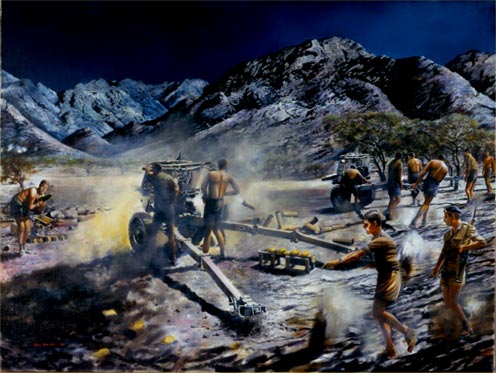| |
« Click on Picture to
Return » |
|
|
 |
|
Engagement at Wadi Ab'ad, Beihan State, Aden
Pack howitzers of 28 Battery in action, at 1300 hrs on 19th March 1965.
On the night of 18th/19th March 1965, two Pack Howitzers of C Section, 28 Battery RA under the command of Lieutenant Martin Proudlock were protected in very low stone sangars. During the night, dissidents opened machine-gun fire from an unexpected direction in the hills, at a range of 300 yards. The guns were immediately moved out of the sangars into open ground, to engage the enemy over open sights. The left-hand gun opened fire, and silenced the enemy machine-gun fire after several rounds. This was achieved before the other gun was able to open fire. (The guns would have been loaded the previous evening, ready for action; therefore the breech block of the far gun is closed).
The shells and their cartridges had previously been removed from their containers, and laid side by side ready for action, (seen at left in the painting). The guns having moved from their original position, the ammunition now had to be carried to the rear of the guns. Being semi-fixed ammunition, the charge and the shell were laid separately behind the breech, then joined together and placed on the wooden 'mating tray' which the gunners had made locally (instead of the usual metal framed mating tray). The four yellow bag charges were loosely laid on top. ('Charge 3' was probably used.)
With the ammunition fed into the breech, the No.3 (Bombardier Nelson) depressed the firing handle, and the hot, empty brass cartridge case was quickly flung to the right by the No.4. Photographs show that the charge bags were thrown to the left. The howitzers were in the 'Three-leg position' (three parts to the trail). As the enemy were in view, the windows in the gun-shields were opened (this is called 'firing over open sights'). Though a No. 3 normally sat down, Bdr Nelson was standing, bracing himself with his left hand. The No.2, sitting on the right trail, operated the trajectory. In addition to the normal dial sight, they had decided (the previous night) to add the anti-tank sight (to the right of the breech).
As the far gun, commanded by Sgt. Young, is swung into position, the No.3 peers through the dial sight.
Mr Martin Proudlock lent me several colour slides and photographs of the men, the guns and the location, many of which were taken on the morning after the action. The enemy were on the lower part of a hill at the end of the valley. The challenge of painting a night scene is how to illuminate the subject. Martin told me there was bright moonlight, 'as bright as day,' and the problem was solved. He said the guns were painted a light sandy gloss colour which reflected the light, and the enemy could see them clearly. Aroused from their sleep, many gunners were wearing grey-blue gym shorts. Lt. Proudlock in the foreground is accompanied by Bdr. Shelbourne, in a beret and carrying a rifle.
The enemy rapidly withdrew, suffering casualties. Almost immediately afterwards, further enemy fire from another position required the guns to open fire again, but by 0200 hrs all was quiet. For this action Lt. Proudlock was awarded the Military Cross.
Bristol University Officers Training Corps kindly demonstrated the drill with the Pack Howitzer for me.
The picture was commissioned by 28 Battery Royal Artillery.
Medium: Oil on Canvas
Printed image size(s): B2 only (58 x 38 cm)
Owner: 28 Battery, 19th Regiment. Royal Artillery.
Price(s): £70
|
|
| |
|
|
|
|
|
|
|
|
|
|
|
|
|
|
|
|











